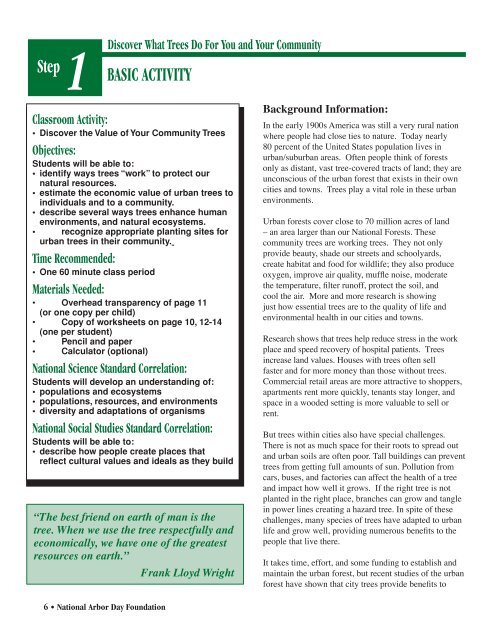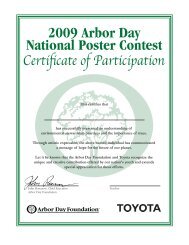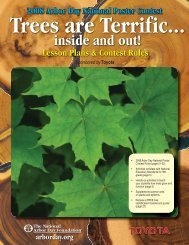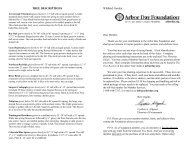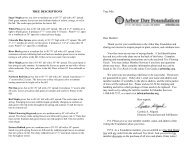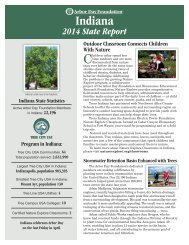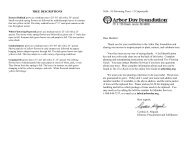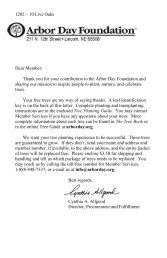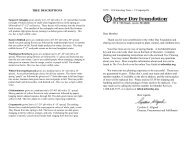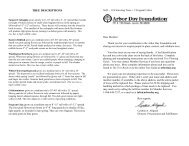Discover What Trees Do For You and Your Community - Arbor Day ...
Discover What Trees Do For You and Your Community - Arbor Day ...
Discover What Trees Do For You and Your Community - Arbor Day ...
You also want an ePaper? Increase the reach of your titles
YUMPU automatically turns print PDFs into web optimized ePapers that Google loves.
Step1<strong>Discover</strong> <strong>What</strong> <strong>Trees</strong> <strong>Do</strong> <strong>For</strong> <strong>You</strong> <strong>and</strong> <strong>You</strong>r <strong>Community</strong>BASIC ACTIVITYClassroom Activity:• <strong>Discover</strong> the Value of <strong>You</strong>r <strong>Community</strong> <strong>Trees</strong>Objectives:Students will be able to:• identify ways trees “work” to protect ournatural resources.• estimate the economic value of urban trees toindividuals <strong>and</strong> to a community.• describe several ways trees enhance humanenvironments, <strong>and</strong> natural ecosystems.• recognize appropriate planting sites forurban trees in their community.Time Recommended:• One 60 minute class periodMaterials Needed:• Overhead transparency of page 11(or one copy per child)• Copy of worksheets on page 10, 12-14(one per student)• Pencil <strong>and</strong> paper• Calculator (optional)National Science St<strong>and</strong>ard Correlation:Students will develop an underst<strong>and</strong>ing of:• populations <strong>and</strong> ecosystems• populations, resources, <strong>and</strong> environments• diversity <strong>and</strong> adaptations of organismsNational Social Studies St<strong>and</strong>ard Correlation:Students will be able to:• describe how people create places thatreflect cultural values <strong>and</strong> ideals as they build“The best friend on earth of man is thetree. When we use the tree respectfully <strong>and</strong>economically, we have one of the greatestresources on earth.”Frank Lloyd WrightBackground Information:In the early 1900s America was still a very rural nationwhere people had close ties to nature. Today nearly80 percent of the United States population lives inurban/suburban areas. Often people think of forestsonly as distant, vast tree-covered tracts of l<strong>and</strong>; they areunconscious of the urban forest that exists in their owncities <strong>and</strong> towns. <strong>Trees</strong> play a vital role in these urbanenvironments.Urban forests cover close to 70 million acres of l<strong>and</strong>– an area larger than our National <strong>For</strong>ests. Thesecommunity trees are working trees. They not onlyprovide beauty, shade our streets <strong>and</strong> schoolyards,create habitat <strong>and</strong> food for wildlife; they also produceoxygen, improve air quality, muffle noise, moderatethe temperature, filter runoff, protect the soil, <strong>and</strong>cool the air. More <strong>and</strong> more research is showingjust how essential trees are to the quality of life <strong>and</strong>environmental health in our cities <strong>and</strong> towns.Research shows that trees help reduce stress in the workplace <strong>and</strong> speed recovery of hospital patients. <strong>Trees</strong>increase l<strong>and</strong> values. Houses with trees often sellfaster <strong>and</strong> for more money than those without trees.Commercial retail areas are more attractive to shoppers,apartments rent more quickly, tenants stay longer, <strong>and</strong>space in a wooded setting is more valuable to sell orrent.But trees within cities also have special challenges.There is not as much space for their roots to spread out<strong>and</strong> urban soils are often poor. Tall buildings can preventtrees from getting full amounts of sun. Pollution fromcars, buses, <strong>and</strong> factories can affect the health of a tree<strong>and</strong> impact how well it grows. If the right tree is notplanted in the right place, branches can grow <strong>and</strong> tanglein power lines creating a hazard tree. In spite of thesechallenges, many species of trees have adapted to urbanlife <strong>and</strong> grow well, providing numerous benefits to thepeople that live there.It takes time, effort, <strong>and</strong> some funding to establish <strong>and</strong>maintain the urban forest, but recent studies of the urbanforest have shown that city trees provide benefits to6 • National <strong>Arbor</strong> <strong>Day</strong> Foundation
Step1<strong>Discover</strong> <strong>What</strong> <strong>Trees</strong> <strong>Do</strong> <strong>For</strong> <strong>You</strong> <strong>and</strong> <strong>You</strong>r <strong>Community</strong>BENEFITS OF TREESbut in urban areas that is especially true if a tree is to grow <strong>and</strong>thrive.Discussion:As each benefit is discussed ask students if they think thatparticular tree benefit results in more of an:• Environmental value – <strong>Do</strong>es it help the ecosystem/environment in which people live?• Economic value – <strong>Do</strong>es it provide an opportunity forpeople or the community to save money by loweredcosts or increased value?• Social value – <strong>Do</strong>es it improve the health or quality oflife for individuals in some way?After going through the h<strong>and</strong>out, ask if planting trees incertain locations can have multiple values?Tell students that even though research is proving theenvironmental, social, <strong>and</strong> economic benefits of trees, weʼrelosing urban trees every day. In some cities, as many asfour trees die or are removed for each new one added. Andnationwide, each day 2,400 acres of rural l<strong>and</strong> is absorbed forurban use <strong>and</strong> most of the trees on that l<strong>and</strong> are not preserved.Surveys indicate that about 66-100 million spaces exist alongour city streets where trees could be planted. This translatesto the potential to absorb 33 million more tons of CO 2everyyear <strong>and</strong> at the same time save consumers $4 billion in energycosts!Be sure to explain that in a city, trees face numerouschallenges like tight spaces, poor soils, <strong>and</strong> city pollution. Itʼsalways important to select the right tree for the right space,Distribute the Benefits of <strong>Trees</strong> Information sheet, <strong>Community</strong>Neighborhood Worksheet <strong>and</strong> the Value of <strong>You</strong>r <strong>Community</strong><strong>Trees</strong> Worksheets (pages 10, 12-14).NOTE: <strong>For</strong> the activity you may choose to have students workin pairs or on their own.STUDENT DIRECTIONS: Tell students to imagine theyeach just received ten free trees from The National <strong>Arbor</strong> <strong>Day</strong>Foundation <strong>and</strong> are going to have an opportunity to plant themin a neighborhood that might be similar to the one where theylive. Students are to draw in (plant) 10 trees in locations onthe <strong>Community</strong> Neighborhood Worksheet, where they feelthe trees might be of the most value...to themselves, to thecommunity – or both. Ask them to please number each treethat they plant, #1-10. Then, on the Value of <strong>You</strong>r <strong>Community</strong><strong>Trees</strong> Worksheets, they should list where they planted each oftheir trees, <strong>and</strong> what environmental, economic, or social valueeach tree might provide in the location they selected. Remindthem to make sure the number of the tree on the <strong>Community</strong>Neighborhood Worksheet corresponds to the number of thetree location described on the Value of <strong>You</strong>r <strong>Community</strong> <strong>Trees</strong>Worksheets.Mention to students that it is always important to plant theright kind of tree in the right location, but for this activity theyshould imagine that they have already selected the appropriatetree species for each location they might select.Give the students the following example:If they planted Tree #1 by the stream it might have:• an environmental value of holding the soil in place;• an economic value of saving the city money by8 • National <strong>Arbor</strong> <strong>Day</strong> Foundation
eduction of storm water runoff;• <strong>and</strong> a social value of adding beauty to the area.Then explain that they should list what value (social, economicor environmental) was the main reason that they selected thelocation for the tree that they did. When they do their treelocation tally they may have 3 trees in one location <strong>and</strong> notrees in another – that is fine. Encourage students to refer tothe Benefits of <strong>Trees</strong> h<strong>and</strong>out or the list on the board for areminder of some of the different benefits trees provide indifferent locations.Pulling It All Together:Allow students about 20 minutes to complete theirworksheets. Then tell students they are going to jump 10 yearsinto the future <strong>and</strong> try to determine the impact <strong>and</strong> the valueof the trees they planted. Explain that they will be able toestimate the value of their community trees.Refer students back to Benefit #10 on their h<strong>and</strong>out thatsays, “Nationally, the 60-plus million street trees have anaverage value of $525 per tree each year.” Tell students tomultiply the number of trees they planted times $525(10 x $525). That will give them a rough idea of the economicvalue from the environmental benefits provided by the treesthey planted in their community. Then, on the board, calculatethe total value of the trees planted by the whole class (# ofstudents x $5250) to demonstrate the impact a group of peopleplanting <strong>and</strong> caring for trees in a community can have on theeconomy of a community.Tell students that if they planted 3 trees around the littlehouse they could give themselves $10,000 for the increasedvalue of their property. If the 3 trees planted around the littlehouse were on the west <strong>and</strong> south side of the house they couldgive themselves an extra $50 in energy savings.Stress to students that although part of this activity wasto estimate the economic value of the trees they planted, theobject is not to see who tallied up the greatest amount ofmoney. The object of the activity is to help students recognizethat trees provide value to our lives in many ways...somevalues are easily measured in terms of dollars <strong>and</strong> cents...somevalues (like the beauty of trees in a park) are subjective fromone person to another <strong>and</strong> are more difficult to measure.Post worksheets on the board so students can comparetree planting locations. Ask them to imagine each of theirneighborhoods joined together, making up a large city. As timepermits, allow students to share their community tree plantingdecisions <strong>and</strong> predict the social, environmental <strong>and</strong> economicimpact of the trees they planted.Assessment Rubric: (To be used with the Value of <strong>You</strong>r <strong>Community</strong> Worksheets)Put the rubric on the board at the start of the activity so students clearly underst<strong>and</strong> themeasured objectives.1- 2 PointsSEED LEVEL3-5 pointsSEEDLING LEVEL6-8 PointsSAPLING LEVEL9-10 pointsTREE LEVEL• Five trees are drawninto the <strong>Community</strong>NeighborhoodWorksheet.• A few planting locationsare identified.• At least one value(social, environmental,or economic) is correctlyidentified for each treedrawn in.• More than half ofthe trees are drawninto the <strong>Community</strong>NeighborhoodWorksheet• Over half the plantinglocations are identified.• At least two values(social, environmental,or economic value) arecorrectly identified foreach tree drawn in.• All 10 trees aredrawn neatly into the<strong>Community</strong> NeighborhoodWorksheet.• Clear descriptions ofthe selected plantinglocations are shown.• At least one social,environmental, <strong>and</strong>economic value iscorrectly identifi ed foreach tree drawn in.• The tree totals arefi lled in on the Value of<strong>You</strong>r <strong>Community</strong> <strong>Trees</strong>Worksheet.• All 10 trees aredrawn neatly into the<strong>Community</strong>Neighborhood Worksheet.• Clear descriptions ofthe selected plantinglocations are shown.• Several social,environmental, <strong>and</strong>economic values arecorrectly identifi ed foreach tree drawn in.• The tree totals arefilled in on the Value of<strong>You</strong>r <strong>Community</strong> <strong>Trees</strong>Worksheet.National <strong>Arbor</strong> <strong>Day</strong> Foundation • 9
Step1<strong>Discover</strong> <strong>What</strong> <strong>Trees</strong> <strong>Do</strong> <strong>For</strong> <strong>You</strong> <strong>and</strong> <strong>You</strong>r <strong>Community</strong>BENEFITS OF TREES1. <strong>Trees</strong> properly placed around a home can reduceair conditioning needs by 30% <strong>and</strong> save 20-30% inenergy used for heating. TRUE. <strong>Trees</strong> planted on thewest <strong>and</strong> south sides of a home help shade <strong>and</strong> cool theair around the home during the summer. <strong>Trees</strong> placed onthe north <strong>and</strong> west sides of a home or building block coldwinter winds. As a result of well-placed trees, there is lessdem<strong>and</strong> for air conditioning <strong>and</strong> heating. Less fossil fuelsare burned, which is good for the environment…<strong>and</strong> yousave money.2. One acre of trees absorbs six tons of carbon dioxide<strong>and</strong> puts out four tons of oxygen. This is enough tomeet the annual needs of 18 people. TRUE. <strong>Trees</strong>remove greenhouse gases, like carbon dioxide, from theair <strong>and</strong> replenish it with oxygen for us to breathe. <strong>Trees</strong>also improve air quality by capturing dust <strong>and</strong> pollutionparticles from dirty city air that can affect human health.These particles cling to the leaves rather than float in theair. When it rains, the dust <strong>and</strong> particles are washed to theground.3. Healthy, mature trees add an average of 10 – 15percent to a propertyʼs value. TRUE. <strong>For</strong> example,a $100,000 home or apartment building might sell for$110,000 ($10,000 more!) if it has trees around it. Treeplanting is one of the best investments a person can makein their home.4. Compared with apartment buildings that had littleor no trees or vegetation, buildings with high levels ofgreenery had 52% fewer total crimes, including 48%fewer property crimes <strong>and</strong> 56% fewer violent crimes.Even a small amount of greenery was associated withlower crime rates. TRUE. Studies have shown livingin an area with trees reduces the stresses that can beassociated with living in a big city. Less stress can easetensions that sometimes lead to violence.5. One shade tree can intercept 760-4,000 gallons ofrainfall in its crown (leafy top) annually, depending onspecies. This reduces runoff of polluted storm water<strong>and</strong> can affect the size of drainpipes <strong>and</strong> retentionponds needed in new developments saving money forthe community. TRUE. The canopy of a tree softens<strong>and</strong> slows the impact of raindrops <strong>and</strong> absorbs water,reducing the amount of water that hits the streets orsidewalks <strong>and</strong> runs immediately to a storm water drainagesystem. Large water management systems are expensive.<strong>Trees</strong> help control runoff, which also improves waterquality, protects the soil, <strong>and</strong> saves money.6. Hospital patients have been shown to recover fromsurgery more quickly <strong>and</strong> require less pain medicationwhen their room had a window that provided a view oftrees. TRUE. It is hard to measure the impact a beautifultree or natural setting can have.7. Living in a home surrounded by woods, meadows,or other natural settings can increase the attentioncapacities of children <strong>and</strong> generally improve theirmental health. TRUE. Even small efforts to improvegreen space – such as preserving existing trees or plantingnew ones <strong>and</strong> maintaining grassy areas – are likely toinfluence the welfare of children.8. The more trees <strong>and</strong> grass in the common spaces ofinner-city neighborhoods, the more those spaces areused by residents. TRUE. Social scientists have foundthat this adds up to more social activities - such as visiting,more knowledge about the neighbors, stronger feelings ofbelonging, <strong>and</strong> the kind of positive social ties that are thevery fabric of a healthy neighborhood.9. The net cooling effect of a young, healthy tree isequivalent to ten room-sized air conditioners operating20 hours a day. TRUE. Amazing! Water from a treeʼsleaves evaporates in the hot weather. The evaporatedmoisture cools the air around the tree. Since cool air isheavier than hot air, this cool air moves toward the groundmaking us feel cooler. Cities, with stretches of concretestreets <strong>and</strong> parking lots, are sometimes referred to as “heatisl<strong>and</strong>s” that are 5-9 degrees hotter than surrounding area.Planting trees in these areas helps lessen the heat isl<strong>and</strong>effect – which saves both energy <strong>and</strong> money.10. Nationally, the 60+ million street trees have an averagevalue of $525 per tree each year. TRUE. Think of allthe things a tree does for the environment. One surveyestimated the value of community trees at $1,700 per tree.10 • National <strong>Arbor</strong> <strong>Day</strong> Foundation
A World With <strong>Trees</strong> WorksheetA WorldWithout<strong>Trees</strong>Silty, floodproneriversSun bakedcitiesRapidrunoffGulliedfarml<strong>and</strong>A WorldWith <strong>Trees</strong>NaturalstreamsShaded homes<strong>and</strong> streets<strong>For</strong>estedslopesProductivefarml<strong>and</strong>National <strong>Arbor</strong> <strong>Day</strong> Foundation • 11


